Features of rotary harrows-hoes
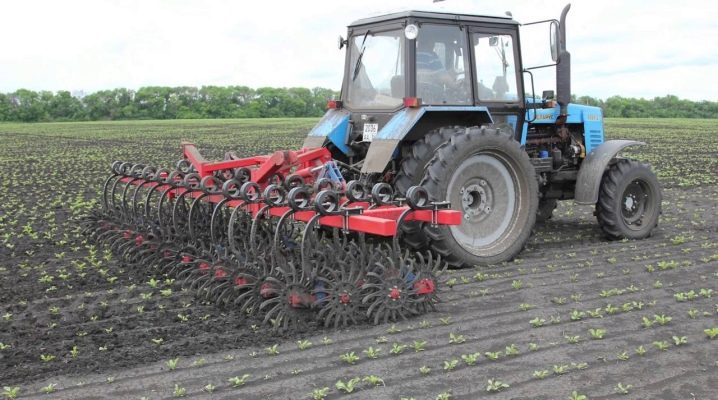
The rotary harrow-hoe is a multifunctional agricultural tool and is actively used for growing various crops. The popularity of the unit is due to the high efficiency of soil processing and ease of use.
Application
The rotary harrow-hoe is designed for surface loosening, increasing aeration and removing carbon dioxide from the soil, as well as for destroying filamentous weeds and combing out large weeds on the surface. With its help, grain, industrial and row crops are harrowed both at the pre-emergence and post-emergence stages. The harrow of this type is well suited for processing soybeans, vegetables and tobacco, and processing can be carried out both in continuous and inter-row methods. The rotary harrow is especially effective in dry areas. This allows you to increase the moisture-saving properties of the soil, which, in turn, has a beneficial effect on the future harvest.
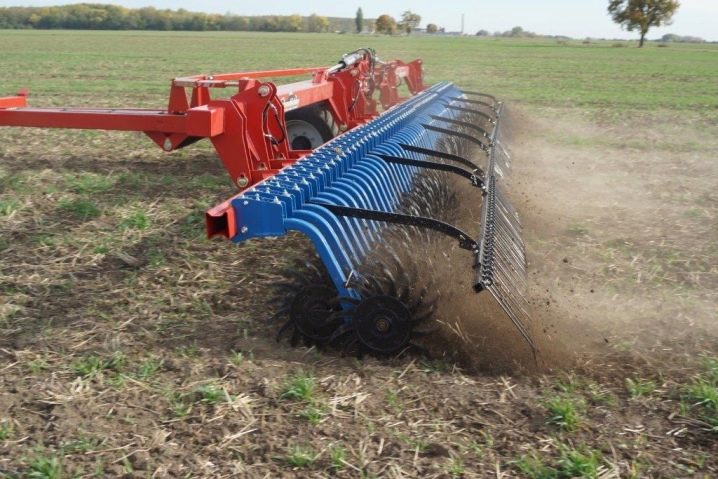
In addition, the hoe harrow promotes the deep introduction of plant residues into the soil, which significantly improves fertility. The machine is very effective in loosening the soil and thanks to the high clearance of the frame it can work the soil with mature plants. Rotary harrows-hoes can be used in all natural zones of our country with soil moisture from 8 to 24% and its hardness up to 1.6 MPa. The devices have proven themselves well not only on flat terrain, but also on slopes with a slope of up to 8 degrees.
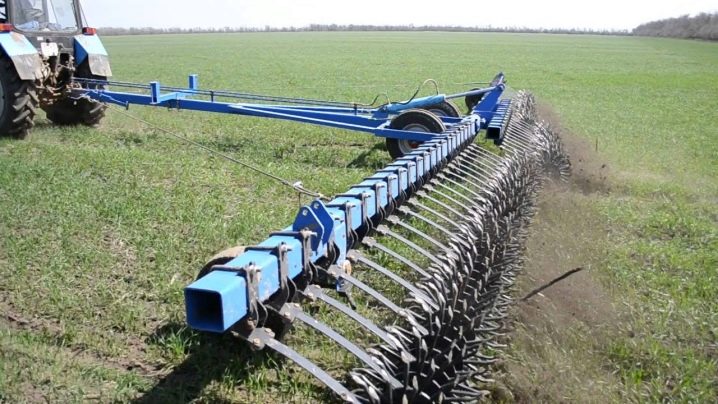
Device and principle of operation
The rotary harrow-hoe consists of a support frame with attached sun-type wheels, which have a diameter of up to 60 cm and are located in several blocks on a spring-loaded swing arm. The mobility of the lever is provided by a special spring, which, due to its extension, acts on the lever itself and the wheels located on it, forcing the entire structure to exert pressure on the soil. The beams-needles that make up the wheels are made of spring steel, screwed or riveted to the disc, and in case of breakage they are dismantled and easily replaced with new ones. Needle discs, in turn, have a movable structure, and can change the angle of attack from 0 to 12 degrees. Rotary harrows-hoes are available in different sizes and can have working widths of 6, 9 and even 12 meters.
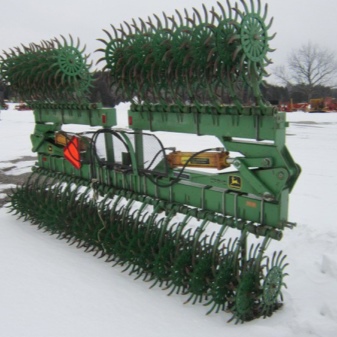

By the type of attachment to the tractor, the harrow can be trailed or mounted. The hinged mounts are mostly lighter models, while the heavyweights are mounted like a trailer. In either case, as soon as the tractor starts moving, the harrow wheels also begin to spin and sink into the ground by 3-6 cm. Due to its sun-like structure, the beams of the wheels break through the hard soil crust and thus facilitate the unhindered penetration of air into the upper fertile soil layer. Thanks to this, the nitrogen present in the air penetrates into the ground and is actively absorbed by the roots of plants. This makes it possible to partially abandon the use of nitrogen-containing fertilizers during the period of seed germination. The cultivation of crops using the needle discs of rotary harrows-hoes is identical to the application of nitrogen at a concentration of 100 kg / ha.
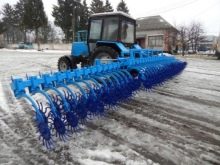
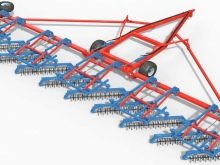

A feature of using hoe harrows is the possibility of a delicate, but at the same time effective impact on the soil. To do this, the discs are installed so that when the needles are immersed in the ground, their convex side looks in the direction opposite to the direction of movement. It is precisely the gentle cultivation of the soil that distinguishes the rotary needle harrows-hoes from the tooth harrows, which are no longer used when the first shoots appear.
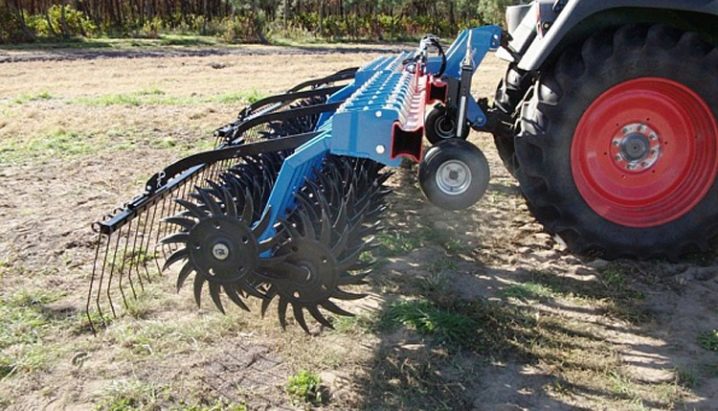
Advantages and disadvantages
Like any type of agricultural machinery, rotary hoe harrows have their own strengths and weaknesses.
The pluses include a very low percentage of plant damage during harrowing, which barely reaches 0.8%. By the way, in the above-mentioned dental models, this figure reaches 15%. In addition, the devices can be used at an early stage of weed control, which is not possible with other types of harrows. Thanks to this, rotary needle models are indispensable for processing corn fields at the stage when 2-3 leaves have already appeared on the shoots. Harrowing in this case is carried out at a speed of 15 km / h, which allows you to get rid of large areas of weeds in a short time.
Judging by the reviews of experienced, farmers, harrows of this type do not have any special complaints, with the exception of the too high cost of some specimens. For example, the price of the BMR-6 unit is 395,000, and the cost of the BMR-12 PS (BIG) model even reaches 990,000 rubles.
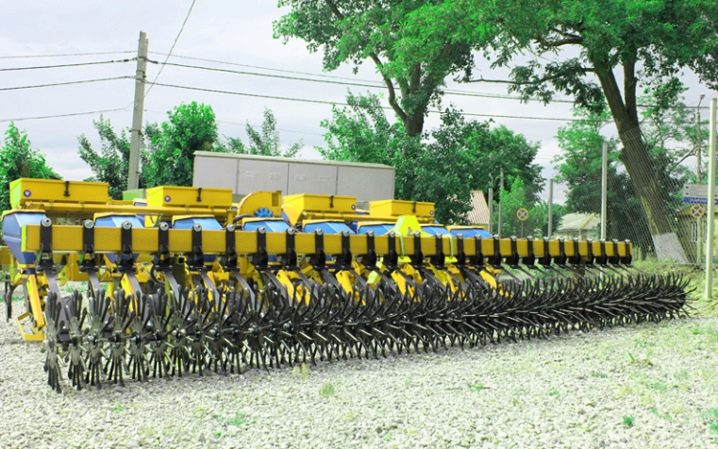
Popular models
Due to the increased consumer demand, manufacturers are producing many different models of rotary harrows-hoes. However, some of them are discussed more often than others in agricultural forums, and therefore require separate consideration.
- Hinged model BMR-12 very common among Russian farmers and is a truly popular model. The unit has a traditional purpose and is used in the processing of cereals, row crops, legumes, vegetables and industrial crops by the continuous or inter-row method. The device is able to effectively prepare the land for sowing and loosen it qualitatively at any stage of the growing season of plants. The productivity of the hoe is 18.3 hectares per hour, and the working width reaches 12.2 meters. The device is designed to operate at speeds up to 15 km / h, and has the ability to connect 56 sections. The ground clearance is 35 cm, which allows you to work on fields with high tops or long stems. Due to the rather large dimensions, the width of the headlands should be at least 15 meters, while for a minimum row spacing, only 11 cm is enough.The device has a rather large processing depth and is capable of entering the ground by 6 cm.The weight of the device is 2350 kg, working dimensions 7150х12430х1080 mm (length, width and height, respectively). The BMR-12 service life is 8 years, the warranty is 12 months.
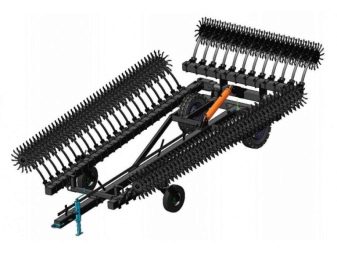
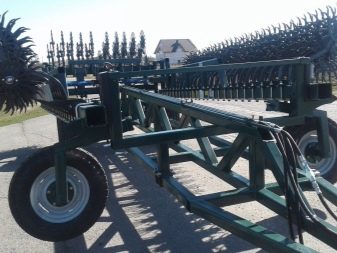
- Model of trailed type BMSh-15T "Iglovator" differs in a small effect on plants, which does not exceed 1.5% at a zero angle of attack, as well as an increased number of needles on one disc to 16. The disc has a diameter of 55 cm and is made of heat-treated alloy steel. The model is equipped with five sections, and the number of discs reaches 180. The distance between the sections is also increased and is 20 cm, while in most other models it is 18 cm. The main difference of the tool is the large weight, reaching 7600 kg, as well as reinforced powerful discs. This allows harrowing to be carried out in extreme external conditions, such as severe drought or large amounts of crop residues. The unit is distinguished by its high productivity and is capable of processing over 200 hectares per day.
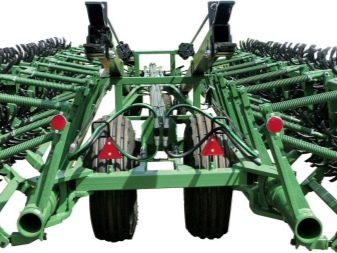
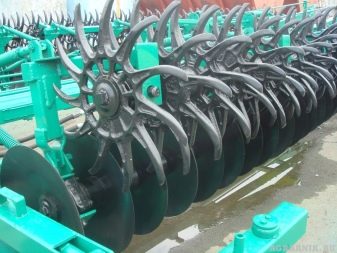
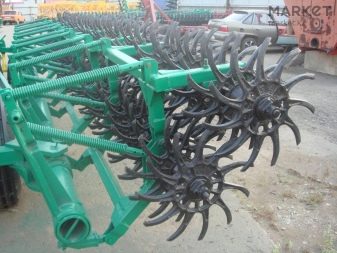
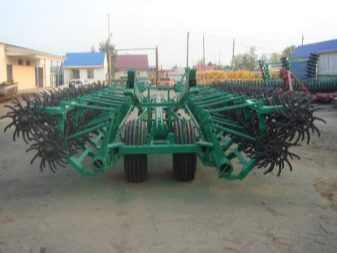
- Mounted harrow hoe MRN-6 is the lightest class of hoes and weighs only 900 kg. The working width is 6 m and the productivity reaches 8.5 ha / h. The device is capable of processing soil at a speed of 15 km / h and deepening into the soil by 6 cm.The number of needle disks is 64 pieces, and aggregation can be carried out by MTZ-80 or any other tractor with a similar type and size of chassis. The service life of the model is 10 years, the warranty is 24 months. The unit is distinguished by good availability of spare parts and high maintainability.

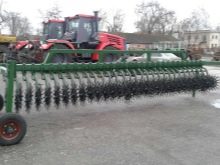

For more information on the features of rotary harrows-hoes, see the video below.




























































The comment was sent successfully.